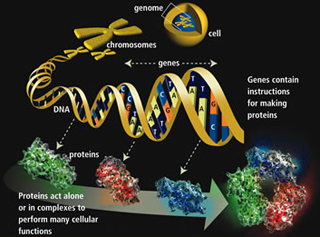
Genes are specific sequences of bases that encode instructions on how to make proteins. It’s the proteins that perform most life functions and even make up the majority of cellular structures. Proteins are large, complex molecules made up of smaller subunits called amino acids. (Illustration courtesy of the Human Genome Program of the U.S. Department of Energy.)
Instructor(s)
Prof. Kim Hamad-Schifferli
Prof. Linda Griffith
MIT Course Number
20.011J / 2.772J
As Taught In
Spring 2004
Level
Undergraduate
Course Description
Course Features
Course Description
This course provides an introduction to the physical chemistry of biological systems. Topics include: connection of macroscopic thermodynamic properties to microscopic molecular properties using statistical mechanics, chemical potentials, equilibrium states, binding cooperativity, behavior of macromolecules in solution and at interfaces, and solvation. Example problems include protein structure, genomic analysis, single molecule biomechanics, and biomaterials.
Other Versions
OCW has published multiple versions of this subject.![]()
Other OCW Versions
Archived versions: ![]()


